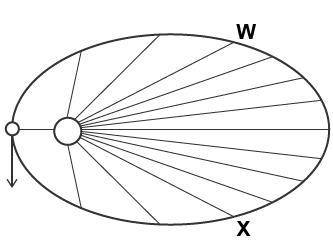
Physics, 04.11.2021 07:00, sokalotus3448
(50 points <3) The image shows how Earth orbits the Sun. Points W and X are the same distance from the Sun.
An illustration with a circle representing the sun and a smaller circle representing a planet. The sun is at a focus of a drawn ellipse that the planet is on. There are lines drawn radially out from the Sun to the elliptical path of the planet. The planet is at the part of the ellipse that is closest to the sun. From the planet a vector is drawn perpendicular to the ellipse and in the counterclockwise direction.
Which conclusion is best supported by the image?
Earth is speeding up at W and slowing down at X because the force on Earth is greater at W than at X.
Earth is slowing down at W and speeding up at X because the force on Earth is greater at W than at X.
The speed of Earth is the same at W as at X because the force on Earth is the same at W as at X.
The speed of Earth is greater at W than at X because the force on Earth is greater at W than at X.


Answers: 1
Other questions on the subject: Physics


Physics, 22.06.2019 15:30, haha81
Identify the correct relation showing that the radius r of the orbit of a moon of a given planet can be determined from the radius r of the planet, the acceleration of gravity at the surface of the planet, and the time τ required by the moon to complete one full revolution about the planet. determine the acceleration of gravity at the surface of the planet jupiter knowing that r = 71 492 km and that t= 3.551 days and r= 670.9 × 10^3 km for its moon europa.
Answers: 2

Physics, 22.06.2019 17:30, Mariaisagon8446
Heterogeneous mixture with larger particles that never settle is
Answers: 2

Physics, 22.06.2019 20:30, nae467
Suppose a force of 60 n is required to stretch and hold a spring 0.1 m from its equilibrium position. a. assuming the spring obeys hooke's law, find the spring constant k. b. how much work is required to compress the spring 0.5 m from its equilibrium position? c. how much work is required to stretch the spring 0.6 m from its equilibrium position? d. how much additional work is required to stretch the spring 0.1 m if it has already been stretched 0.1 m from its equilibrium? a. kequals 600
Answers: 2
Do you know the correct answer?
(50 points <3) The image shows how Earth orbits the Sun. Points W and X are the same distance fro...
Questions in other subjects:





Mathematics, 14.11.2019 06:31





Mathematics, 14.11.2019 06:31






